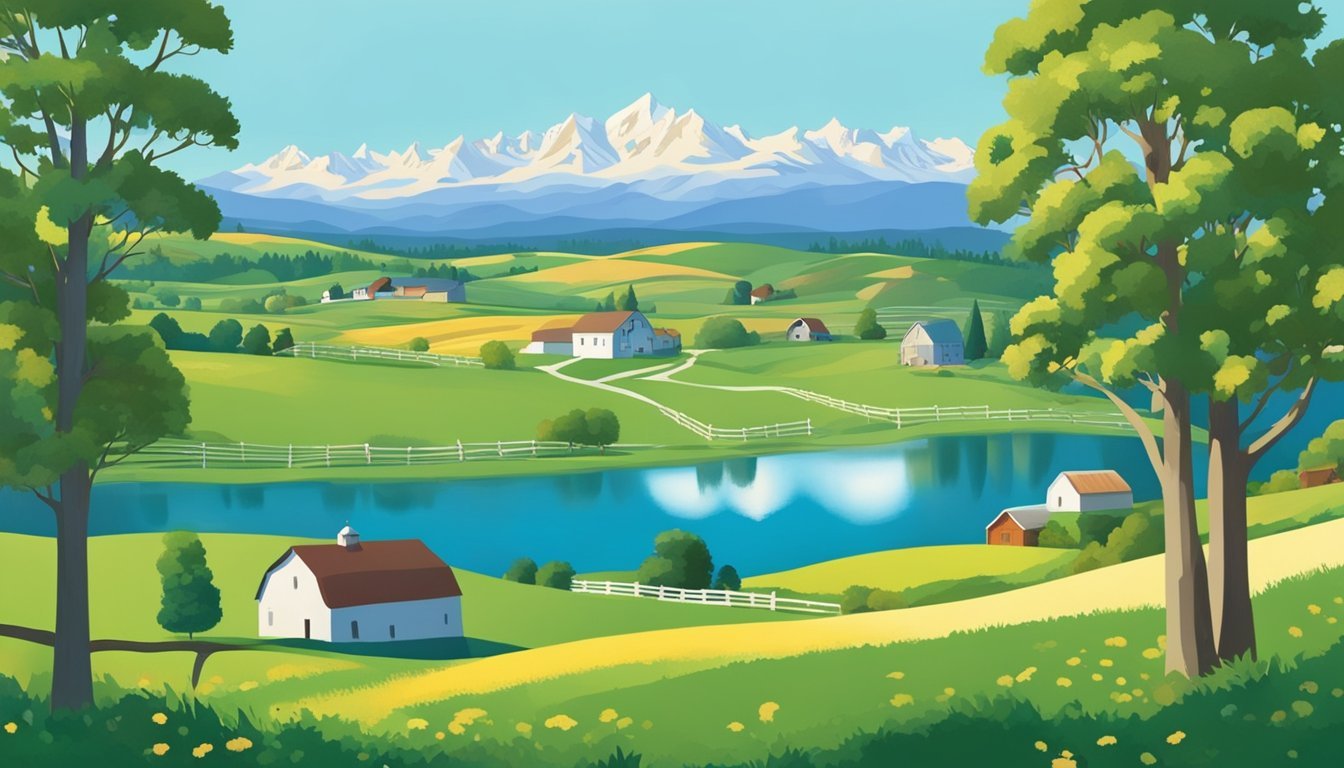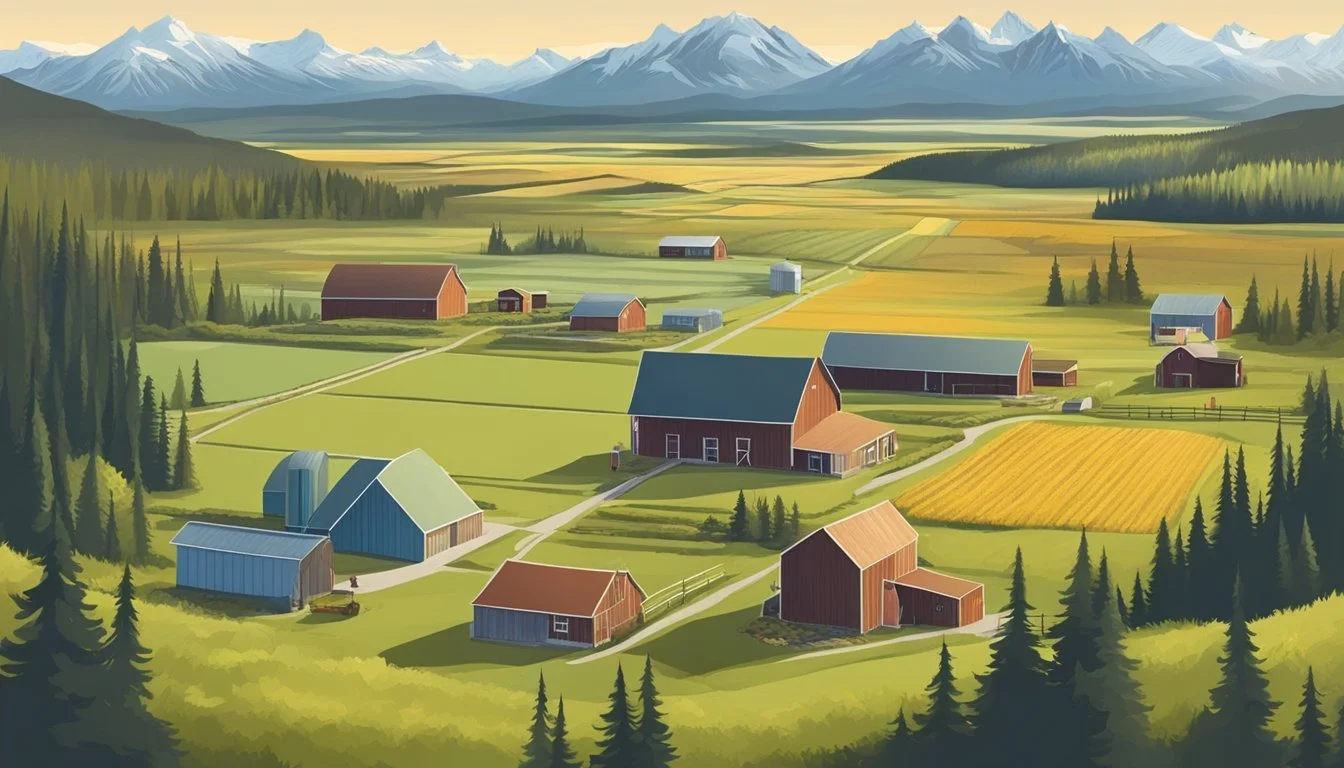Small Farms for Sale in Alaska
Your Guide to Buying Rural Property
This Article is Part of State-by-State Guide to Buying Your First Small Farm
Alaska's vast landscapes offer unique opportunities for small-scale agriculture, characterized by their distinct challenges and rewards. With an increasing interest in sustainable living and local food production, small farms for sale in Alaska are gaining attention from both in-state and out-of-state buyers. These properties often range from under ten acres to sizable parcels that can support more expansive operations. The market for these farms is diverse, with a selection of properties available across different regions, each with its own climatic conditions and geographical features.
The availability of small farms in the Kenai Peninsula, Matanuska-Susitna Borough, and other regions illustrates the varied agricultural landscape of Alaska. These farms provide potential owners with the chance to engage in a self-sufficient lifestyle or to develop businesses catering to the growing demand for local, organic produce. The properties vary greatly in terms of infrastructure and resources, making it crucial for prospective buyers to consider their specific needs and goals when evaluating different listings.
Investing in Alaskan farmland requires an understanding of the unique aspects of farming in the state, such as the shorter growing season, the need for specialized equipment, and the potential for tourism-related activities. Buyers must navigate factors like remote access, soil quality, and the availability of local markets. With careful planning and resource management, small farms in Alaska can become successful operations, contributing to the local economy and the state's agricultural diversity.
Overview of Small Farms in Alaska
Alaska presents a unique opportunity for prospective buyers looking to own small farms—whether for personal enjoyment or agricultural productivity. The real estate landscape in Alaska includes a range of diverse small farms, from hobby farms with residences to more extensive mini farms and farmettes suitable for a variety of livestock, including goats, sheep, and poultry.
Market Snapshot:
Average Listing Price: Small farms in Alaska have varied prices, with an average around $1,248,767.
Price per Acre: The cost per acre averages approximately $51,114, offering a spectrum of affordability depending on size and location.
Those interested in Alaskan farms will find properties endowed with natural beauty and the potential for diverse farming activities. The land for sale often comes with the benefits of privacy and seclusion, features that are characteristic of Alaska's vast wilderness.
Types of Farms:
Hobby Farms: Ideal for personal recreational use or small-scale agriculture.
Rural Mini Farms: Suitable for more extensive farming operations.
Country Farmettes: Often includes acreage for animals or small crop production.
Purchasers of Alaska farm real estate can anticipate acreage that may incorporate functional attributes such as gravel pits for personal use or sufficient land for potential expansion. Accessibility to natural resources and the charm of remote living are also potential advantages, particularly for those seeking to establish a lifestyle close to nature or to embark on commercial agricultural ventures.
For more specific interests, the Alaska Interior boasts smaller farms, blending affordability with the region's distinctive rural charm. These properties maintain an average listing price significantly lower than the state average, reflecting Alaska's diverse real estate market.
Benefits of Investing in Small Farms
Investing in small farms in Alaska presents numerous advantages, particularly in terms of sustainability and financial benefits. The manageable scale of these properties often leads to a more personalized approach to farming and can result in a highly efficient operation.
Sustainability and Self-Sufficiency
Small farms in Alaska can be bastions of sustainability and self-sufficiency. Given Alaska's vast and varied landscapes, small-scale farming enables adaptability to specific environmental conditions. Farmers can leverage the extended growing days during the Alaskan summer to maximize crop production in an eco-friendly manner. This level of self-sustenance not only contributes to local food security but also reduces the carbon footprint associated with long-distance food transportation.
Financial Advantages of Small-Scale Farming
The financial advantages of investing in small-scale farming in Alaska are multi-faceted. While the average and median purchase prices for small farms are not universally fixed and can vary widely based on location and acreage, smaller farms typically require lower initial investment compared to larger agricultural enterprises. This can offer:
A lower entry price point for aspiring farmers.
The potential for higher per-acre productivity, as intensive cultivation methods can be more easily managed on a smaller scale.
Opportunities for niche markets, capitalizing on the demand for local, sustainably produced food, potentially allowing for a more robust profit margin despite smaller production volumes.
By focusing on these distinct sustainability and financial advantages, investors can make informed decisions about the potential of small-scale farms in Alaska.
Key Considerations When Buying
When examining small farms for sale in Alaska, one must thoroughly understand the legal and environmental aspects that could affect the use and enjoyment of the property.
Zoning and Land Use Restrictions
Zoning regulations govern how one can use the land. Prospective buyers should:
Verify zoning classifications before purchasing to ensure it aligns with their intended use.
Check for land use restrictions that could impact farming activities.
Local ordinances and state regulations may regulate building on the property, subdivision of land, and specific types of farming operations. Buyers should consult the borough's planning department for the most accurate and current information.
Soil and Climate Conditions
Soil fertility and climate are critical to farm viability. Buyers should consider:
The type of soil present on the land and its suitability for the crops they plan to grow.
Climate factors such as average temperatures, growing season length, and precipitation patterns.
Prospective buyers might investigate historical climate data and consult with local agricultural extension services for insights on managing land under Alaskan conditions.
It's important to note that farms in Alaska can range from a few acres to much larger expanses of land. Buyers need to assess whether the size of the farm meets their agricultural needs and whether they can effectively manage the unique challenges posed by Alaska's environment.
Understanding the Alaskan Market
When exploring small farms for sale in Alaska, it’s essential to understand the local market dynamics, which are characterized by variability in terms of average listing price, price per acre, and listing age.
Average Listing Price and Trends
Average Listing Price: The Alaska farm and ranch market showcases a range of average listing prices. For instance, properties in the Valdez-Cordova Census Area are listed for around $1,495,000 for 33.5 acres, while an 87-acre farm in the Fairbanks North Star Borough is up for approximately $489,900. These differences are affected by various factors, including location, accessibility, and the type of farm or ranch.
Region Average Listing Price Listing Age Valdez-Cordova Census Area $1,495,000 8 months Fairbanks North Star Borough $489,900 40 days Matanuska-Susitna Borough $25,000,000 7 months Kenai Peninsula Borough $329,000 -
Trends: Alaskan land values are influenced by several trends, such as the demand for recreational and subsistence farming, as well as the interest of buyers seeking solitude and natural beauty. Listing age varies, suggesting a diverse turnover rate from region to region.
Price per Acre Analysis
Price per Acre: Calculating the price per acre offers a clearer understanding of the value being offered. For example, the asking price in the Fairbanks North Star Borough averages to approximately $5,632 per acre, while the monumental 881-acre listing in the Matanuska-Susitna Borough is priced much higher given its size and potential value.
Analysis:
Properties with substantial acreage and features, such as existing buildings or proximity to wildlife refuges, potentially command higher prices.
The price per acre is lower in areas with larger parcels and older listings, indicating a possible buyers' market.
In summary, when considering purchasing small farms in Alaska, buyers should analyze the specific region of interest, understand the current market trends, and conduct a thorough price per acre evaluation to ascertain the value of the investment.
Types of Small Farms Available
The Alaskan real estate market offers diverse small farming options suitable for a range of agricultural activities. These include arable farms for cultivation, livestock operations, and specialized crop production, each tailored to the unique climates and landscapes of Alaska.
Arable Farms
Arable farms in Alaska typically feature the cultivation of grains, vegetables, and other crops that can thrive in the northern environment. Available acreage varies, with properties ranging from 5 acres in the Matanuska-Susitna Borough to larger parcels of 40 acres or more. Prospective buyers can find land suited for small-scale farming to larger operations, enabling a range of agricultural pursuits.
Size: 5 acres and up
Location Examples: Matanuska-Susitna Borough, Kenai Peninsula Borough
Livestock Operations
For those interested in animal husbandry, Alaska presents small farm opportunities for raising livestock such as cattle, reindeer, and yaks. Land parcels for livestock operations are offered with varying acreage, catering to the needs of small herds or larger flocks.
Animal Types: cattle, reindeer, yaks
Example Acreage: 20-acre lots suitable for smaller herds
Specialty Crop Production
Specialty crop production entails the cultivation of plants suitable for Alaska's unique climate, including berries and other hardy perennials. Small farms dedicated to niche markets provide distinct opportunities for agricultural entrepreneurs.
Crops: berries, hardy perennials
Potential: suitable for niche markets
Steps to Purchasing a Small Farm
When embarking on the journey to purchase a small farm in Alaska, prospective buyers should pursue a structured approach that begins with a financial assessment, advances through diligent property search and evaluation, and culminates in the closing process.
Assessing Financial Readiness
Prospective buyers should start with a thorough examination of their financial standing. This includes reviewing savings, projected farm income, and securing pre-approval for a loan. A realistic budget must encompass the initial purchase price as well as ongoing operational costs.
Property Search and Evaluation
Once financial readiness is established, buyers need to engage in a comprehensive property search. They should identify farms that align with their requirements in terms of:
Size (e.g., 5 to 50 acres)
Location (e.g., Matanuska-Susitna Borough or Kenai Peninsula Borough)
Price range
Land quality and suitability for intended agricultural activities
Evaluating a property involves scrutinizing its soil quality, access to water, structures on the land, zoning laws, and potential for growth and sustainability.
The Closing Process
Upon choosing a suitable property, the buyer should proceed with the closing process. This involves:
Performing due diligence, including a title search and property inspection.
Negotiating the sale terms and price.
Preparing and reviewing the sales agreement, which should detail all the terms of the purchase.
Finally, the buyer will finalize the transaction, sign the necessary legal documents, and complete the payment to take ownership of the farm.
Financial Assistance and Resources
Financial avenues are available for prospective buyers and current owners of small farms in Alaska, providing essential capital for starting or expanding agricultural operations.
Grants and Loans for Small Farms
Alaska Rural Rehabilitation Corporation (ARRC): This non-profit offers agricultural loans and can be a pivotal resource for farmers and ranchers.
Farm Service Agency (FSA): The Alaska State FSA, a federal entity, supplies various loan programs tailored to the agricultural sector.
Educational Programs and Workshops
Farm education programs and workshops provide valuable knowledge and skills for small farm owners. Resources for these include:
USDA Cooperative Extension Service: This nationwide network offers educational resources to improve farm management.
Local agricultural associations regularly conduct workshops and seminars.
Prospective Growth and Future Trends
The Alaska agricultural landscape is witnessing significant growth with small farms' average property size encompassing diverse acreages suitable for various agricultural practices. Advancements in technology and shifts in market demands are central to this development.
Technology Integration in Farming
Small farms in Alaska are increasingly adopting technology to enhance productivity and sustainability. The integration of precision farming tools helps manage farm resources effectively, leading to increased yields and reduced waste. A key example is the use of drones for monitoring crop health and soil conditions, enabling farmers to make informed decisions. Recently, properties from 5 to over 100 acres have been reported to implement technological solutions that were once associated with larger operations.
Market Demands and Consumer Trends
Market trends in Alaska show a growing preference for locally-sourced and sustainable produce among consumers. This is reflected in the burgeoning number of small farms catering to organic markets and farm-to-table establishments. The data reveals a shift towards agricultural properties under 50 acres, positioning them to quickly adapt to consumer needs. Furthermore, Alaska's changing climate has extended growing seasons, allowing for a wider variety of crops to be farmed and marketed to the conscious consumer.
Conclusion
The Alaskan real estate market offers a variety of small farm properties that cater to a range of needs and budgets. Prices for these farms can span from a modest starting point to over a million dollars, reflecting the diversity in size and amenities offered. For instance, Kenai Peninsula Borough and Matanuska-Susitna Borough are notable areas where small farm properties are frequently listed.
Kenai Peninsula Borough and Matanuska-Susitna Borough showcase properties inclusive of:
5-acre lots estimated around $65,000 to $169,900.
20-acre plots ranging from $167,000 to $329,000.
Potential buyers must observe that prices and availability are subject to change and should verify the current market status.
Conclusion Island, interestingly, appears in listings but denotes a lack of available properties at the moment. Those interested may choose to monitor this area for future opportunities or explore other promising locales within Alaska.
Investors and individuals need to consider their specific requirements, including the size of the farm, type of land, budget constraints, and location preferences when exploring options in Alaska's robust market. They are encouraged to conduct thorough research or seek professional advice to make well-informed decisions on farm purchases in the state.






